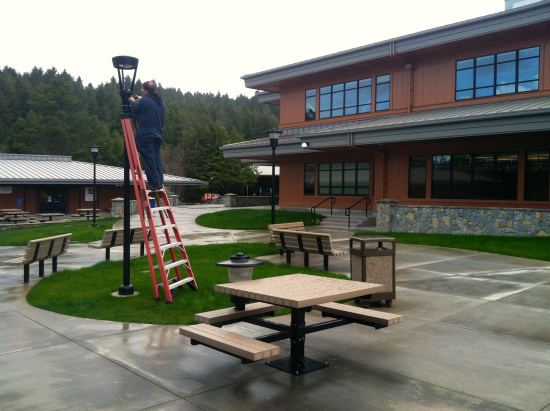A maintenance worker fixes a lamp in CR’s new quad.
Note: This is the third of five parts in the LoCO‘s weeklong series on College of the Redwoods and its recovery from accreditation trouble. Today’s installment looks at the nitty gritty of how CR addressed its deficiencies.
In February 2012, College of the Redwoods found out that it had an important deadline. By October 15 of that year, school officials had to submit a report to the Accrediting Commission for Community and Junior Colleges (ACCJC), the body that was threatening to revoke its seal of approval, a move that would likely have closed down the college. This report had to show, in detail, how the school would address its identified shortcomings and, furthermore, how it was meeting every single one of the commission’s standards. And after the commission received that report, a team would come visit CR for a closer look.
That looming judgment day created an “extreme sense of urgency,” said Geoscience Professor David Bazard, who served as co-chair of CR’s accreditation committee. Along with his fellow co-chair (initially Keith Snow-Flamer, CR’s vice president of instruction and student development, and later Interim President Utpal Goswami), Bazard put together groups and sub-groups to deal with each of the commission’s recommendations and articulate the logic behind each response.
In its Feb. 2012 letter to the college, the accrediting commission had identified eight shortcomings. One concerned documentation of student learning outcomes; another touched on strategic planning; and another pertained to employee diversity. Some of the issues were fairly straightforward — making sure students get an adequate syllabus for each class, for example. Others, such as creating “a comprehensive professional development program,” would be more time-consuming.
Looking for some wisdom on this type of predicament, CR’s accreditation oversight team brought in outside consultants and asked for advice from other community colleges that had successfully recovered from “show cause” sanctions, including Diablo Valley College and Solano Community College.
“It was a considerable amount of work,” Bazard said.
Over the summer of 2012, the various subgroups worked separately to address each problem and then fed information back to the accreditation oversight committee. Together the teams developed new policies and procedures, methodically assembling a response to the accrediting commission in the form of a 372-page report (which is available here under the link called “10/15/12 Show Cause Report,” in case you’re the kind of scholar/masochist who enjoys reading that sort of thing).
CR President/Superintendent Kathy Smith said that some of the underlying issues at the college hadn’t been identified in any report or checklist.
“One thing I was surprised at when I got here [in May 2012] was the lack of trust, because I’d never worked in a place like that before,“ she said.
Under former President Jeff Marsee, relations between campus employees had become mired in suspicions and territorial defensiveness. In 2010 the faculty union, College of the Redwoods Faculty Organization (CRFO), filed two lawsuits against the administration alleging that Marsee had made unilateral decisions that amounted to unfair practices and bad-faith bargaining.
The cases have since been resolved, but in working to address CR’s sanctions, Smith found that faculty and staff were still wary.
“One of the things that kept coming up, they wanted all of the policies to be ‘president proof,’” she said. “I was like, ‘OK, what does that mean?’” Eventually she figured out that that there was a lack of trust in the college’s so-called “participatory governance” system — an organizational setup that incorporates checks and balances between staff, faculty and administrators.
Gradually, through the process of discussion and negotiation, that trust was rebuilt. “We finally said — instead of, ‘What would protect us?’ — ‘What would a healthy college’s policy look like?’” Smith said.
The oversight committee made the Oct. 15 deadline, submitting its lengthy report to the ACCJC, and last November a two-person team from the accrediting commission made a follow-up visit. In February, CR got word that it was being removed from all sanctions.
Looking back on the process, Bazard said the work was valuable.
“I think in many cases it made CR a better place,” he said. “We work in a state institution. You need to be able to show what you’re doing, document it.” One example of improved accountability: CR’s webpage now features a syllabus for every course offered on campus, and Bazard said there’s better documentation and communication from the Board of Trustees, which helps hold the president accountable. And as a result of one of the faculty union lawsuits, CR’s faculty now has the right to address the board directly at each meeting.
Tomorrow we’ll take a look at how and why CR has downsized, with its controversial decisions to eliminate certain classes and programs, suspend operations at its Garberville site and potentially stop offering classes altogether at its Mendocino County instructional site in Fort Bragg.
PREVIOUSLY:

CLICK TO MANAGE